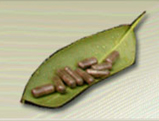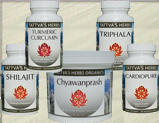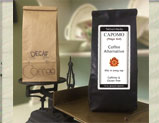 Loading... Please wait...
Loading... Please wait...Providing 25 Years Of Premium Service
Storewide Sale - Save 20%
Blog - General Health Information ayurvedic
Nature’s Bounty: Currying Favor With the Brain
Posted by Daniel A. Marano, published on November 01, 2009 – last reviewed on May 27, 2011 on 31st Mar 2011
It is becoming increasingly difficult to make the distinction between food and drug. As scientists gain the ability to study the chemical components of food—notably fruits and vegetables—and trace their actions and interactions in our bodies at a molecular level, they’re finding that they contain potent bioactive compounds that have the capacity to improve overall health and even treat hard-core diseases.
The most important of these compounds also often create the most colorful of plants. They are classified as polyphenols, flavonoids being the most widely studied in the lab. You hopefully consume them in the form of fruits and berries; wine, tea and coffee; olives and so many more edibles. There are thousands of them. Their raison d’etre is to protect plants from damage ranging from solar radiation to fungal disease. The often-colorful agents prove to be just as important to the protection and longevity of our own bodies. And few prove to be more dazzling or potent than those found in turmeric.
Turmeric belongs to the ginger family, and the rhizome looks like a miniature version of fresh ginger. Although it lacks ginger’s zing, it boasts a distinctive orange flesh that has the ability to stain bright yellow everything that comes into contact with it. Native to Southeast Asia, turmeric is used extensively in both medicine and cooking. It can be found fresh at many Asian markets in the U.S. and, increasingly, in the produce section of larger organic markets.
Dried and pulverized, the turmeric root becomes the spice that imparts the yellow color to American mustard and curry powder. That might be all you know of it. But across Asia and Africa, turmeric has long been prized both as a fabric dye and as a medicine noted for antibacterial and anti-inflammatory properties.
Turmeric’s scientific name is Curcuma longa, and the polyphenolic compound that imparts the yellow color is called curcumin. It has become the focus of much research in the U.S. and elsewhere for its ability to fight inflammation and cancer and to interfere with the onset of cognitive decline associated with neurodegenerative diseases, particularly Alzheimer’s.
Fresh turmeric contains no more than 4 percent curcumin, which, on its own, is poorly absorbed by the body. But lipids increase the rate of absorption—just as butter and olive oil boost the bioavailability of similarly colorful and healthful phenolic compounds like lycopene in tomatoes and carotenoids in carrots.
Turmeric plays an important role in traditional Chinese medicine as a component of herbal formulas that fight stress and depression. Ongoing research has shown curcumin to greatly reduce the effects of stress and the inflammatory cascades implicated in depression and other behavioral disorders.
In studies of Alzheimer’s disease, curcumin is proving to halt the buildup of amyloid-beta plaque that clogs the brain’s neural pathways and triggers the condition. Amyloid-betas are basically chains of amino acids, or proteins. They are to neurodegenerative diseases what fatty arterial plaque is to heart disease.
Given the limited bioavailability of curcumin, many of the most promising studies are now looking at synergistic pairings of the agent with other compounds to boost its power. The Journal of Alzheimer’s Disease recently reported a study looking at the effects of combining curcumin with vitamin D3, a nutrient we make from exposure to sunshine .
Using both naturally occurring curcuminoids and more bioavailable synthetic versions, scientists at UCLA and at UC Riverside were able to boost beneficial immune activity in Alzheimer’s patients. The spice supercharged the immune system’s macrophages to hunt down and bind with the harmful amyloid-beta plaque, taking the toxic substance out of commission.
Curcumin appears to target multiple facets of Alzheimer’s in addition to binding amyloid molecules to be carted off by the immune system. In separate studies at UCLA’s Alzheimer’s Research Laboratory, neuroscientists Greg Cole and Sally Frautschy are scrutinizing the role curcumin plays in safeguarding the brain. In a recent issue of the Journal of Neuroscience, they reported the ability of curcumin, combined with omega-3 fatty acids, specifically DHA, to deliver a one-two punch to amyloid-beta plaque, combating both its production and its harmful buildup in brain tissue.
At the University of Michigan, chemist Ayyalusamy Ramamoorthy is focused on elucidating curcumin’s general operating mechanisms. “Very interesting things are happening at the cellular membrane level, with the lipid and polyphenol interaction rather than the protein interactions,” he reports. With the use of advanced nuclear magnetic resonance imaging techniques his lab has pioneered, he is homing in on how curcumin fortifies cell membranes. His interest in the spice is not accidental; he grew up in India, where he was given turmeric-infused milk as a cold remedy and the “holy powder” is prized for its ability to fight congestion and heal wounds.
Curcumin is a kind of molecular disciplinarian most comfortable ensconced in the fatty membranes of cell walls, where it can help the cell resist viruses and even malignancy, says Ramamoorthy: “The membrane goes from being crazy and floppy to being more disciplined and ordered, so information flow through it can be controlled.” Even at low concentrations, the spice exerts profound effects on cellular membranes, he reports in the Journal of the American Chemical Society. It could be of value not just against Alzheimer’s but other degenerative disorders like Parkinson’s and even diabetes.
Ramamoorthy and colleagues are thinking both smaller and broader. They are creating nanoparticles of curcumin and using NMR imaging to compare curcumin to other powerful plant compounds like resveratrol (in grapes and red wine) and capsaicin (the heat in red chilies). The goal is to illuminate just how phenolic compounds grab our attention—not just by their color but by their ability to improve human health, longevity, and cognition.
NICE SPICE
In addition to its ability to combat neurodegeneration, curcumin has many other potential health and medical uses now under investigation.
- Herpes infection: Studies have shown that low levels of the spice interfere with replication of the herpes simplex virus.
- Gastrointestinal cancer: Trials in patients with colorectal cancer show that oral supplementation can produce bioactive levels of the compound in the gut.
- Arthritis: Curcumin is under investigation in numerous labs for its ability to block signaling pathways that lead to inflammation.















